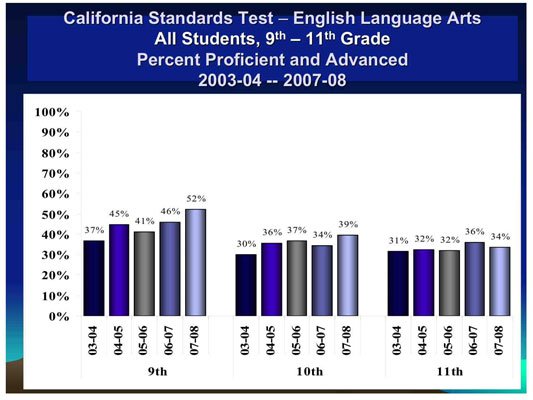Gilroy students are making the grade and school administrators
are seeing some of the best progress on standardized test scores in
the past five years.
Gilroy students are making the grade and school administrators are seeing some of the best progress on standardized test scores in the past five years.
The California Department of Education recently released the results of the 2008 Standardized Testing and Reporting Program and Gilroy scores are up in each category, across almost all grades and subgroups, said Rob van Herk, director of assessment and data systems. Not only are more students performing at the proficient and advanced performance levels, fewer students are performing at the far below basic and below basic levels.
Districtwide, students performing at the proficient or advanced level – the two levels that count as annual yearly progress by state and national standards – increased 3.4 percentage points in English/language arts and 3.1 percentage points in mathematics, according to the CDE Web site.
“This is really, really good,” van Herk said, comparing previous years’ data to this year’s results. “We found that if you look at all the schools, in English/language arts and math, there are significant gains out of far below and below (basic) into basic and there’s definite growth moving students into proficient and advanced.
“In the past five years, we’ve never had as few students in far below and below (basic) or as many in proficient and advanced.”
STAR scores provide the numbers that contribute to a district’s Academic Performance Index. Only two schools, El Roble Elementary and Antonio Del Buono Elementary, are not expected to improve their API this year, district estimates show. Official API scores will be released Sept. 4.
The Gilroy Unified School District’s percentage of proficient or advanced students surpassed the statewide percentage in math and came up two points short in English/language arts.
A chart summarizing the district schools’ gains and losses between 2007 and 2008 showed that most schools followed the trend, moving more students out of the lowest two levels and more into the top two.
Only five schools – Antonio Del Buono, El Roble, Luigi Aprea, South Valley and Brownell – bucked the trend in one way or another, either shrinking their pools of high performers or increasing the number of low performers.
Overall, Eliot Elementary School made some of the biggest gains, moving 17.5 percent of its students out of the far below basic and below basic performance bands and 11.2 percent into the proficient or advanced performance bands in English/language arts. In math, Eliot moved 21.2 percent out of far below basic and below basic levels and 23.3 percent into proficient or advanced levels.
District charts show steady progress at each grade level over the last five years. Twenty-seven percent of fifth graders were proficient or advanced in math in 2004. In 2008, 22 percent more fifth graders performed at the highest levels. Only 17 percent of eighth graders performed at proficient or advanced levels in math in 2004. Since then, that number has more than doubled and 41 percent of eighth graders are now proficient or advanced in math.
Meanwhile, math performance hit a peak in the third grade with 65 percent of students performing at the proficient or advanced level, dropping to less than a third of that in the eleventh grade, at 21 percent. A similar trend followed in the area of English/language arts. Scores peaked in the fourth grade at 51 percent proficient or advanced, leveled off for a few years in the 40s, peaked again in the ninth grade at 52 percent, and dropped to a a woeful 34 percent in the eleventh grade.
Overall, elementary school students performed better on math and middle and high school students performed better in language arts.
Certain subgroups, specifically English learners, didn’t mirror the progress of their English-speaking counterparts. The progress of English learners toward proficient or advanced levels was much more erratic across grade levels, according to the state’s data. Nearly as dismal as last year’s figures, English learners performed at their peak in their early years and dropped off to a point where 83 percent were performing at the far below basic and below basic levels on English/language arts. By the 11th grade, only 2 percent of English learners were proficient in English/language arts. None were advanced. However, this was an improvement over last year’s 1 percent that scored at the proficient level.
“The biggest thing is that so few kids are in far below and below (basic),” van Herk said.














